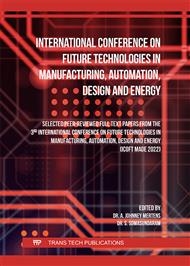[1]
Mckinsey Global Institute. (27 de febrero de 2017). Reinventing construction through a productivity revolution. McKinsey & Company: https://www.mckinsey.com/business-functions/operations/our-insights/reinventing-construction-through-a-productivity-revolution
Google Scholar
[2]
Changali, S., Azam, M., & Mark, N. (2015). The construction productivity imperative. Retrieved from McKinsey & Company: https://www.mckinsey.com/business-functions/operations/our-insights/the-construction-productivity-imperative#
Google Scholar
[3]
Saka, A.B. and Chan, D.W.M. (2020), "Profound barriers to building information modelling (BIM) adoption in construction small and medium-sized enterprises (SMEs): An interpretive structural modelling approach", Construction Innovation, Vol. 20 No. 2, pp.261-284
DOI: 10.1108/CI-09-2019-0087
Google Scholar
[4]
Adel M, Cheng Z, Lei Z. Integration of Building Information Modeling (BIM) and Virtual Design and Construction (VDC) with Stick-Built Construction to Implement Digital Construction: A Canadian General Contractor's Perspective. Buildings. 2022; 12(9):1337
DOI: 10.3390/buildings12091337
Google Scholar
[5]
Allen, J.F.; Koomen, J.A. Planning using a temporal world model. In Proceedings of the Eighth International Joint Conference on Artificial Intelligence, San Francisco, CA, USA, 8–12 August 1983; Volume 2, p.741–747.
Google Scholar
[6]
Khanzode, A. (2010). An Integrated, Virtual Design and Construction and Lean (IVL) Method for Coordination of MEP. Stanford University: https://purl.stanford.edu/db106qv2525
Google Scholar
[7]
Gao, Z., Aslam, M., & Smith, G. (2021). Integrated Implementation of Virtual Design and Construction (VDC) and Lean Project Delivery System (LPDS). Obtenido de Journal of Building Engineering Vol. 39:
DOI: 10.1016/j.jobe.2021.102252
Google Scholar
[8]
Kunz, J., & Fischer, M. (2012). Virtual Design and Construction: Themes, Case Studies and Implementation Suggestions. CIFE Working Paper #097: https://cife.stanford.edu/virtual-design-and-construction-themes-case-studies-and-implementation-suggestions
Google Scholar
[9]
Didehvar, N., Hosseinalipour, M., & Mohebifar, A. (2018). Benefits and Challenges of Applying Virtual Design and Construction (VDC). Journal of Structural and Construction Engineering, 5(Special Issue 3), 139-152
Google Scholar
[10]
Khanzode, A., Fischer, M., & Reed, D. (2008). Benefits and lessons learned of implementing building virtual design and construction (VDC) technologies for coordination of mechanical, electrical, and plumbing (MEP) systems on a large healthcare project. Journal of Information Technology in Construction: https://www.itcon.org/2008/22
Google Scholar
[11]
Kunz, J., & Fischer, M. (2020) Virtual design and construction, Construction Management and Economics, 38:4, 355-363
DOI: 10.1080/01446193.2020.1714068
Google Scholar
[12]
Rischmoller, L., Reed, D., Khanzode, A., & Fischer, M. (2018). Integration Enable by Virtual Design & Construction as a Lean Implementation Strategy. 26th Annual Conference of the International Group for Lean Construction. Chennai, India, 18-20 Jul 2018. pp.240-249:
DOI: 10.24928/2018/0521
Google Scholar
[13]
Del Savio, A.A.; Vidal Quincot, J.F.; Bazán Montalto, A.D.; Rischmoller Delgado, L.A.; Fischer, M. (2022) Virtual Design and Construction (VDC) Framework: A Current Review, Update and Discussion. Appl. Sci. 2022, 12, 12178. https:// doi.org/
DOI: 10.3390/app122312178
Google Scholar
[14]
Sasaki (2018). "University cities"—as planned university campuses are typically known in Latin America—are undergoing a massive shift and this university is at the leading edge. Sasaki. https://www.sasaki.com/projects/universidad-de-lima-master-plan/
Google Scholar
[15]
Universidad de Lima (2021) Universidad de Lima implementa sistemas de energía solar para su autoconsumo. Universidad de Lima. https://www.ulima.edu.pe/ulima/noticias/universidad-de-lima-implementa-sistemas-de-energia-solar-para-su-autoconsumo#:~:text=Con%20su%20capacidad%20de%2056,prevista%20para%20noviembre%20de%202021.
DOI: 10.46631/jefas.2007.v12n22.07
Google Scholar


